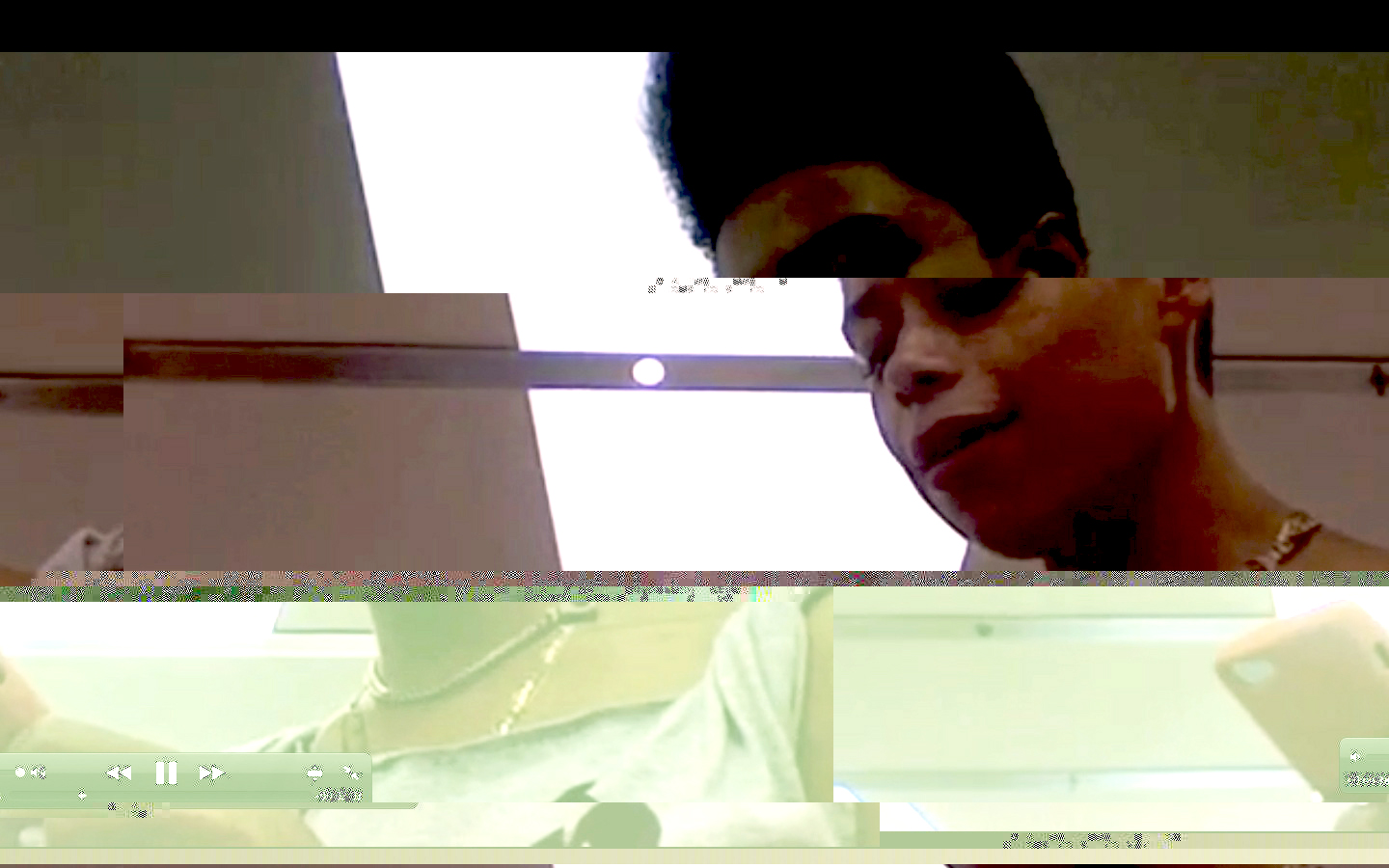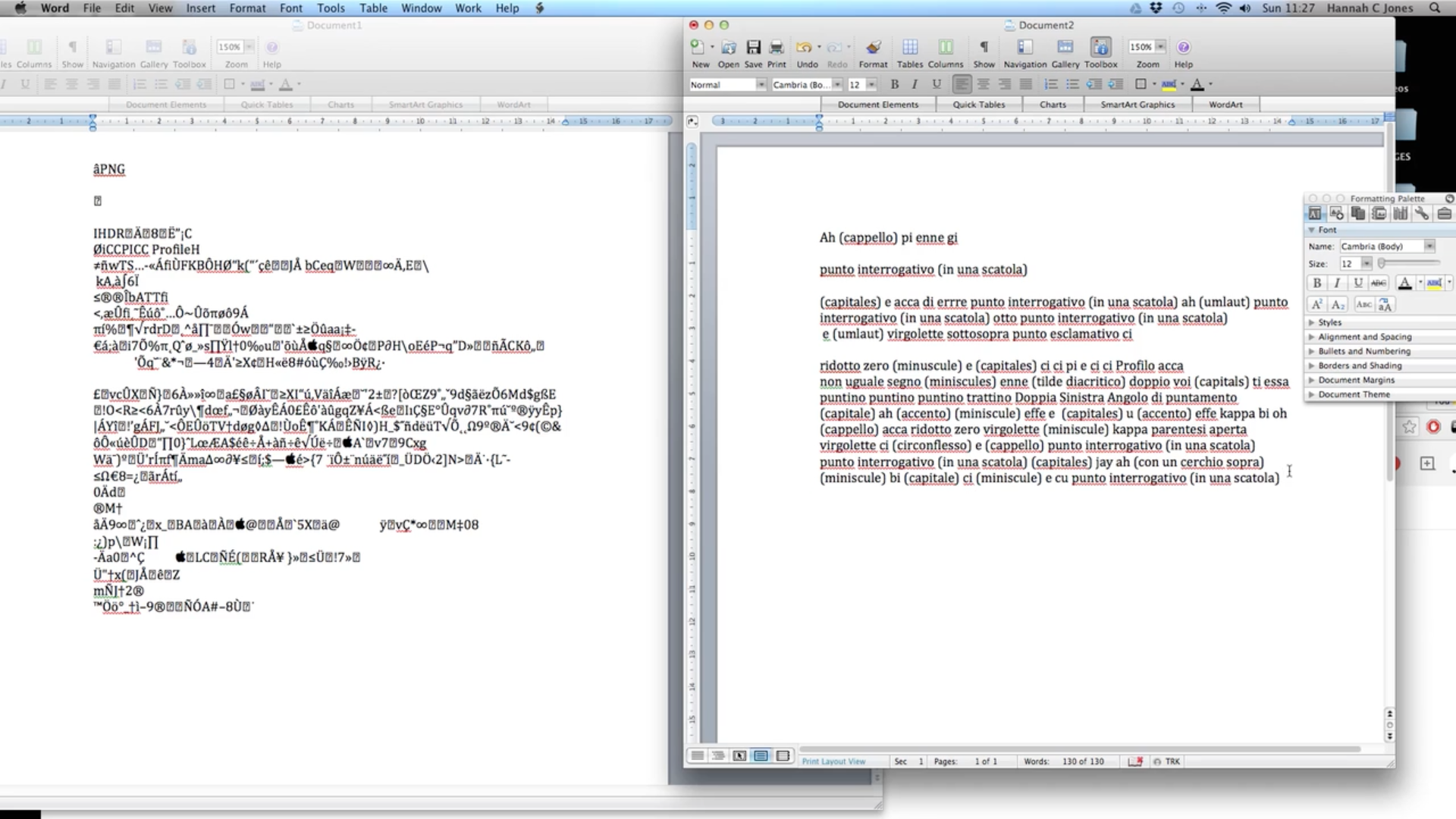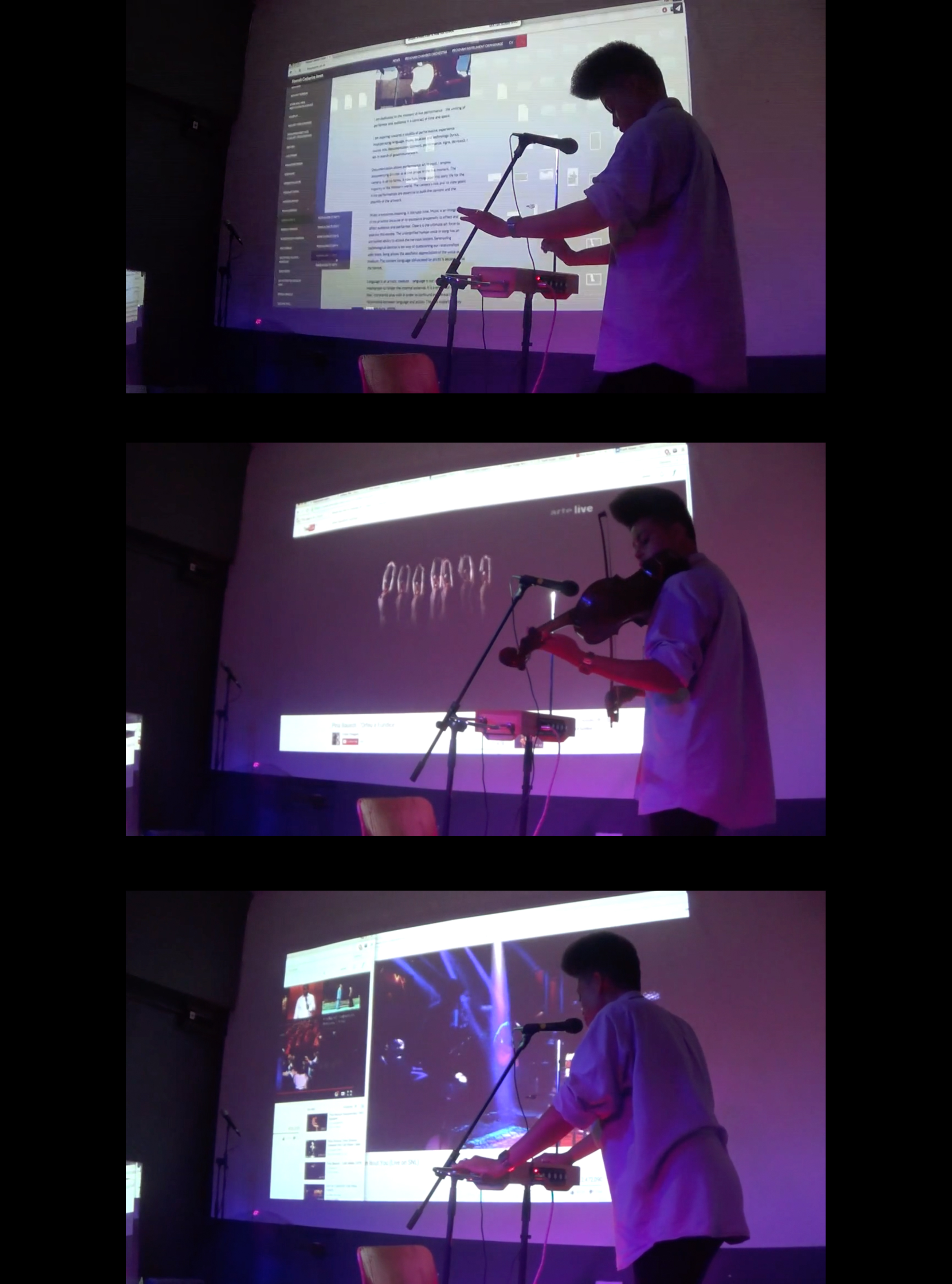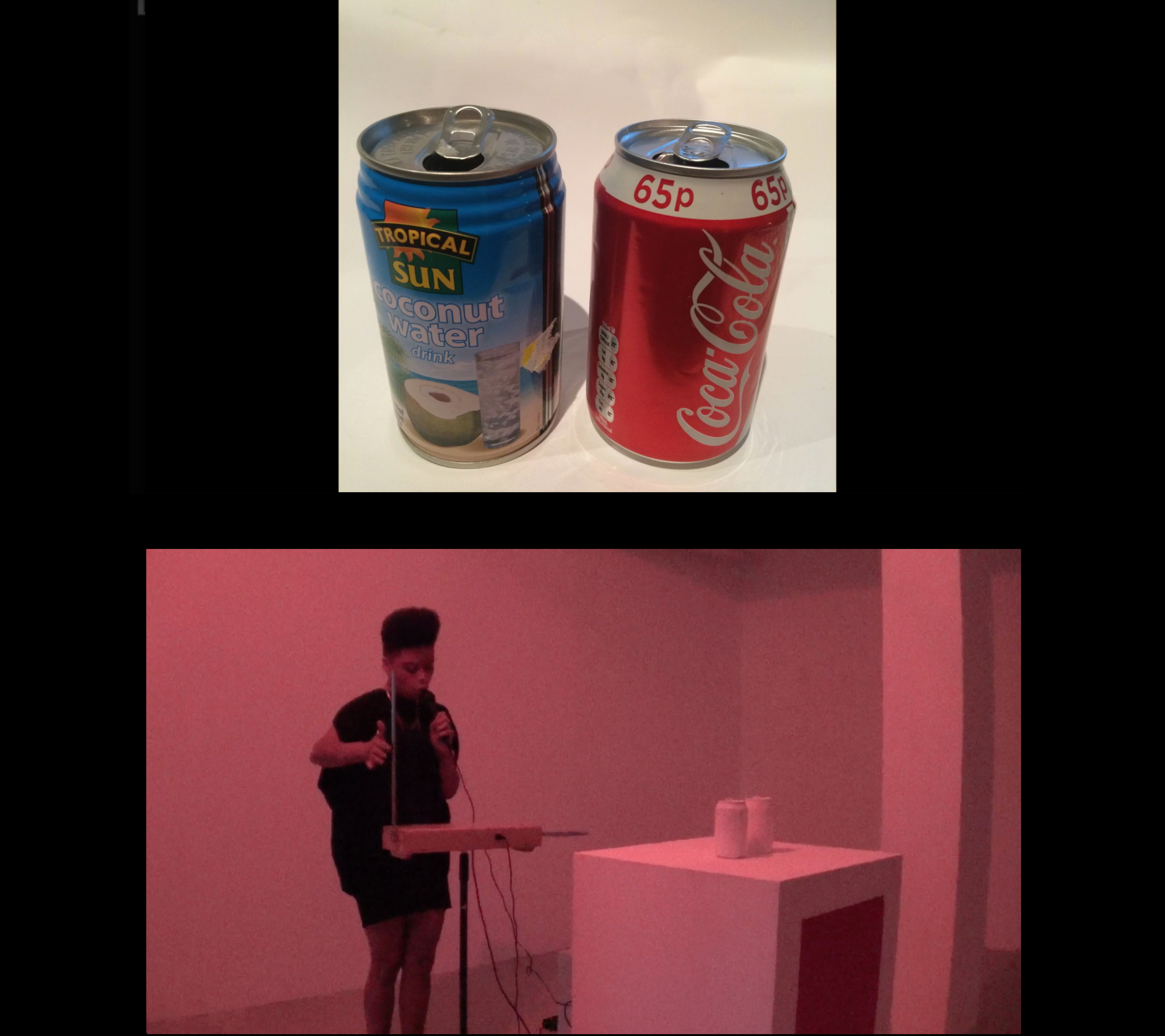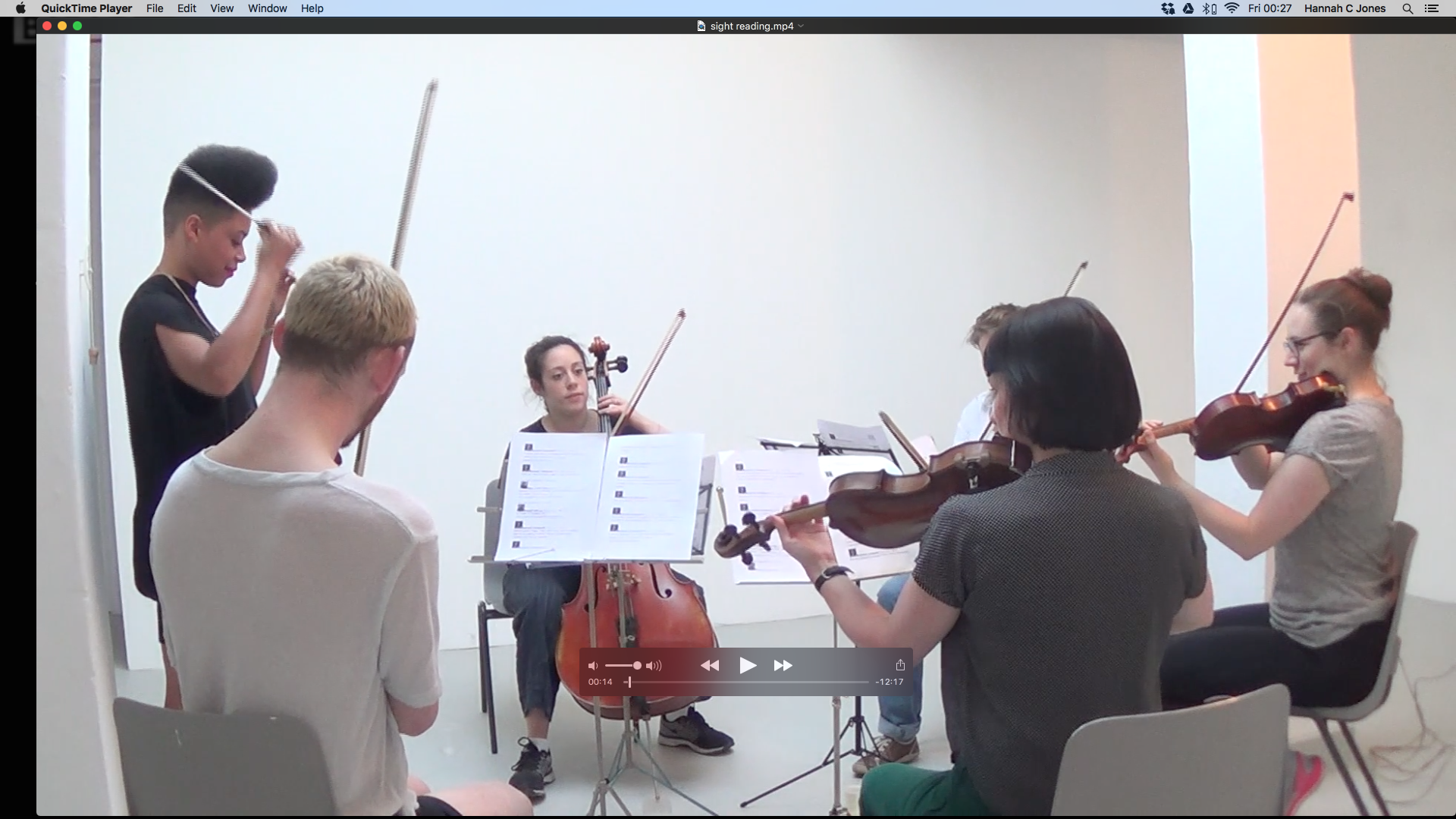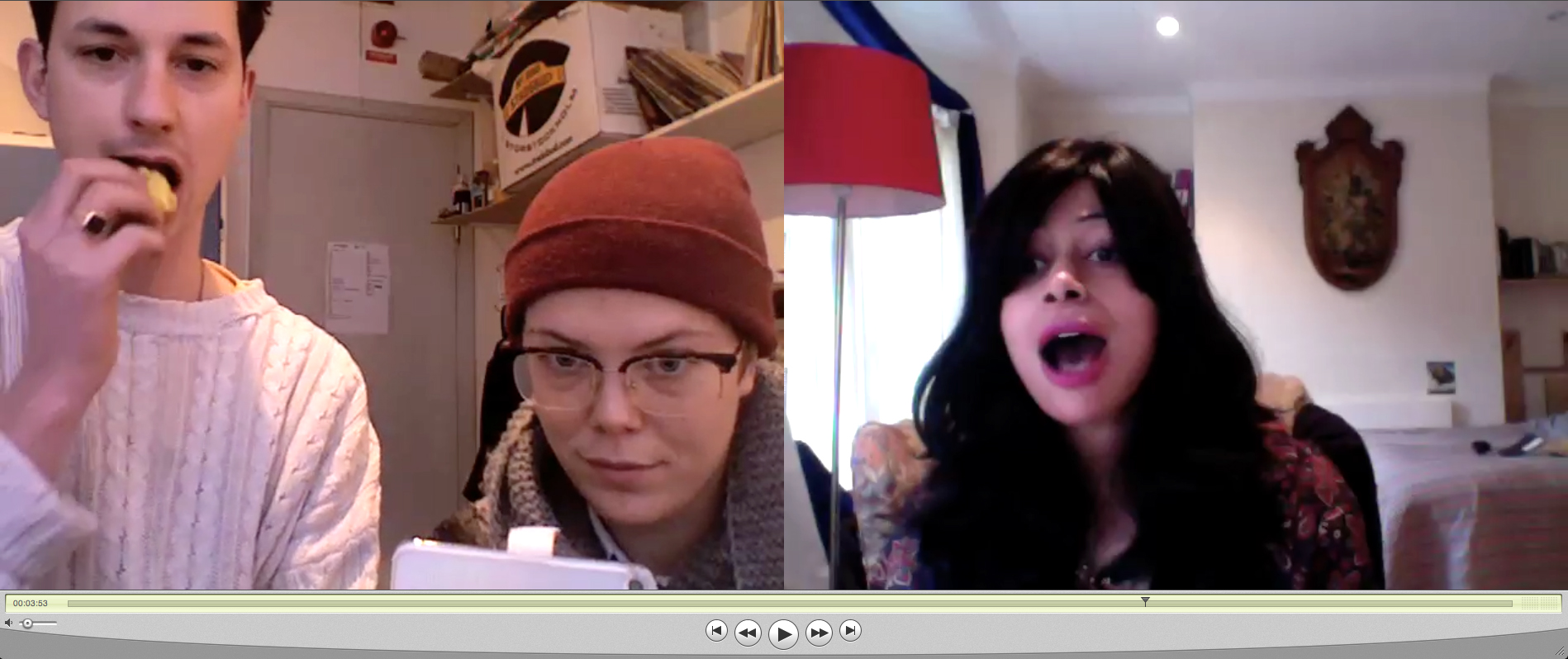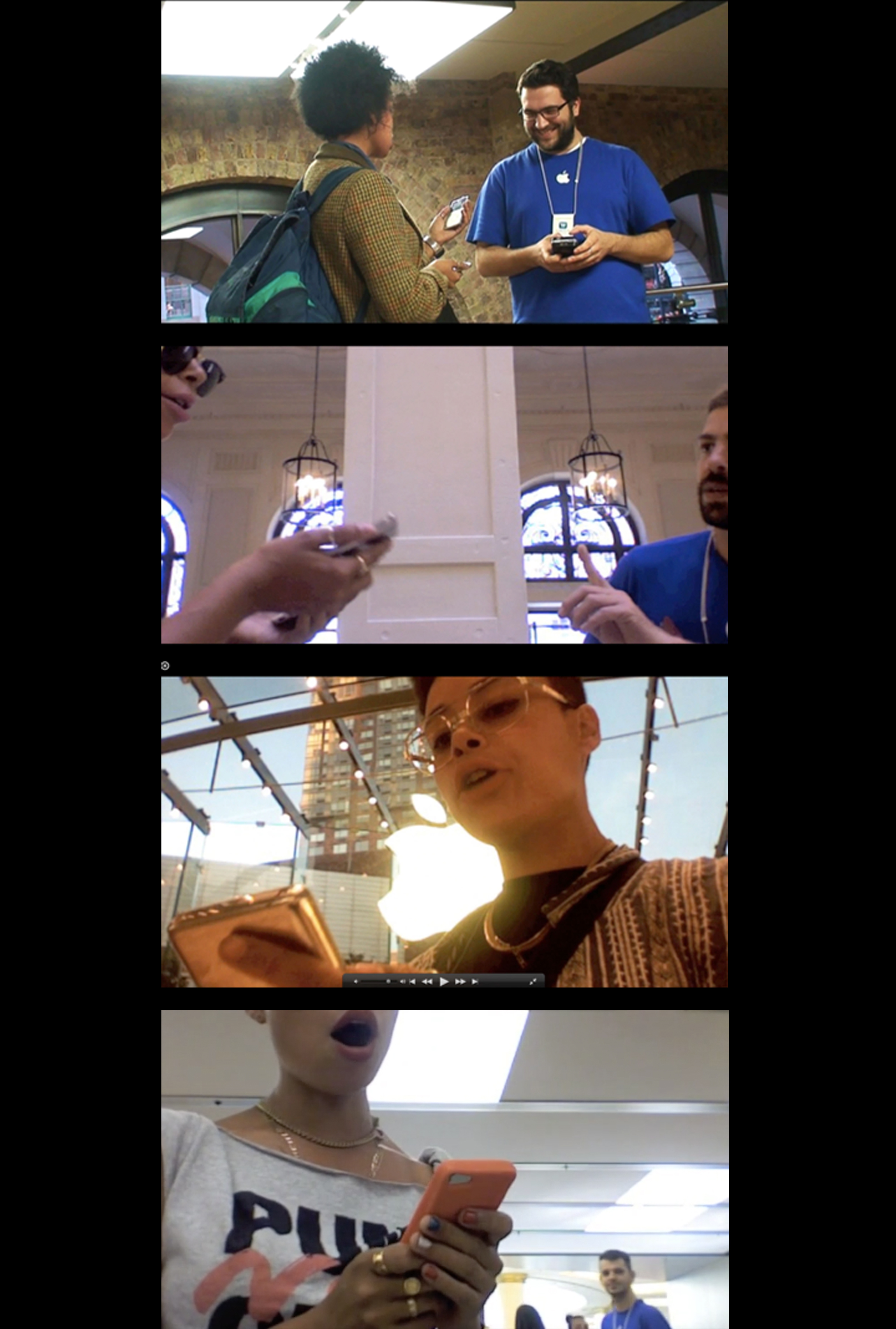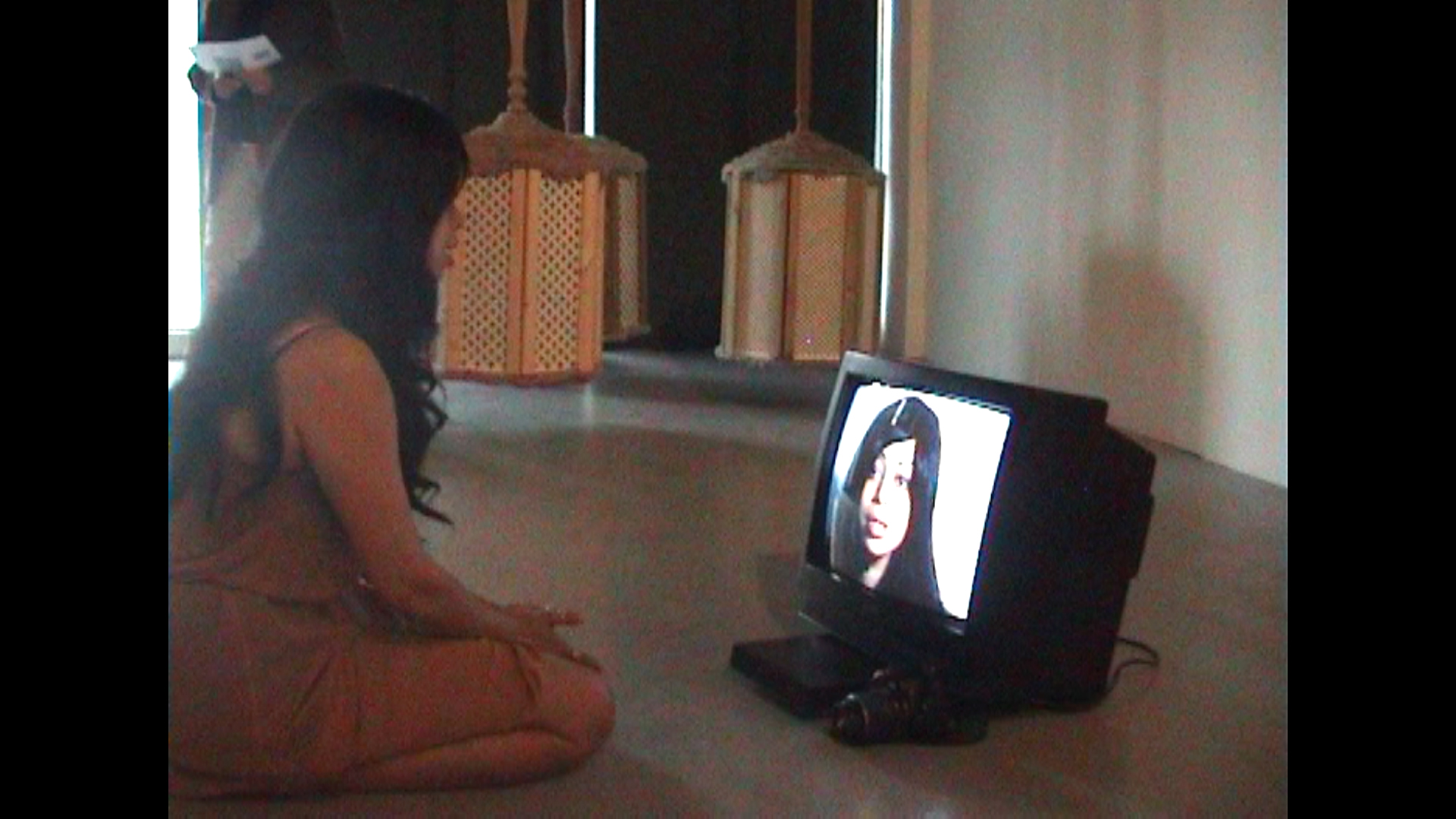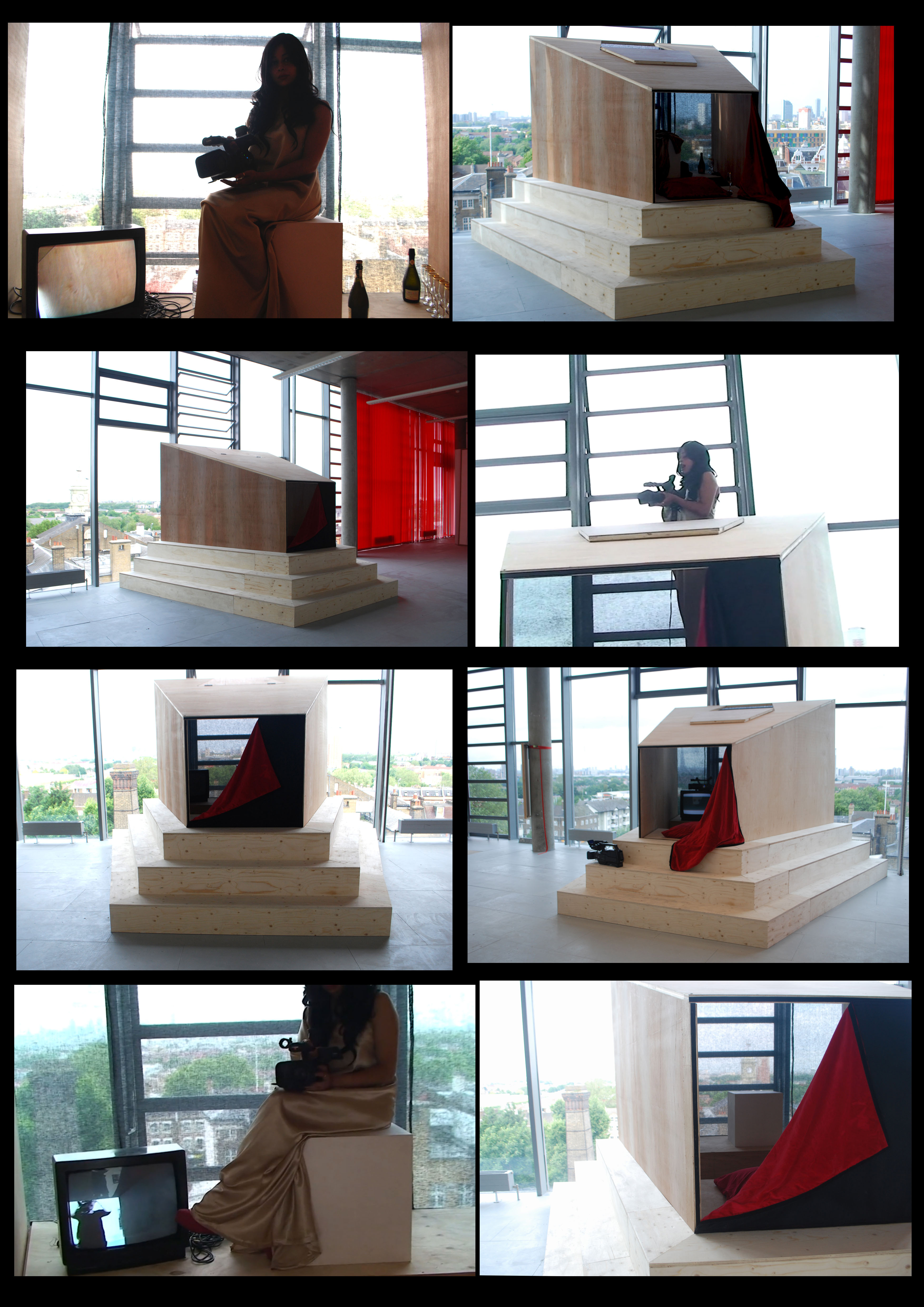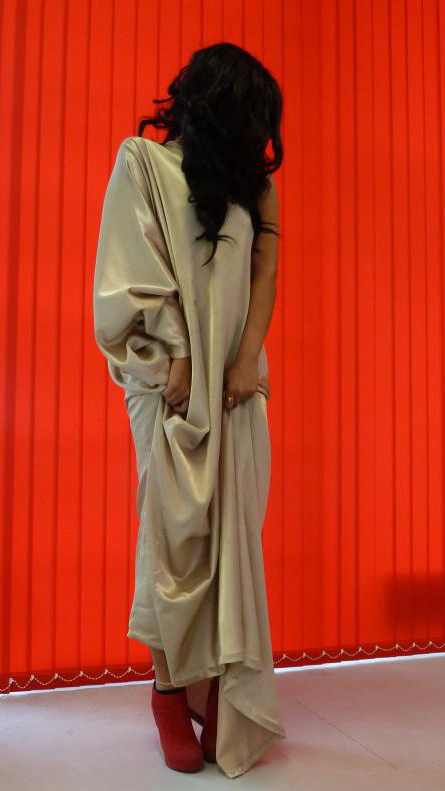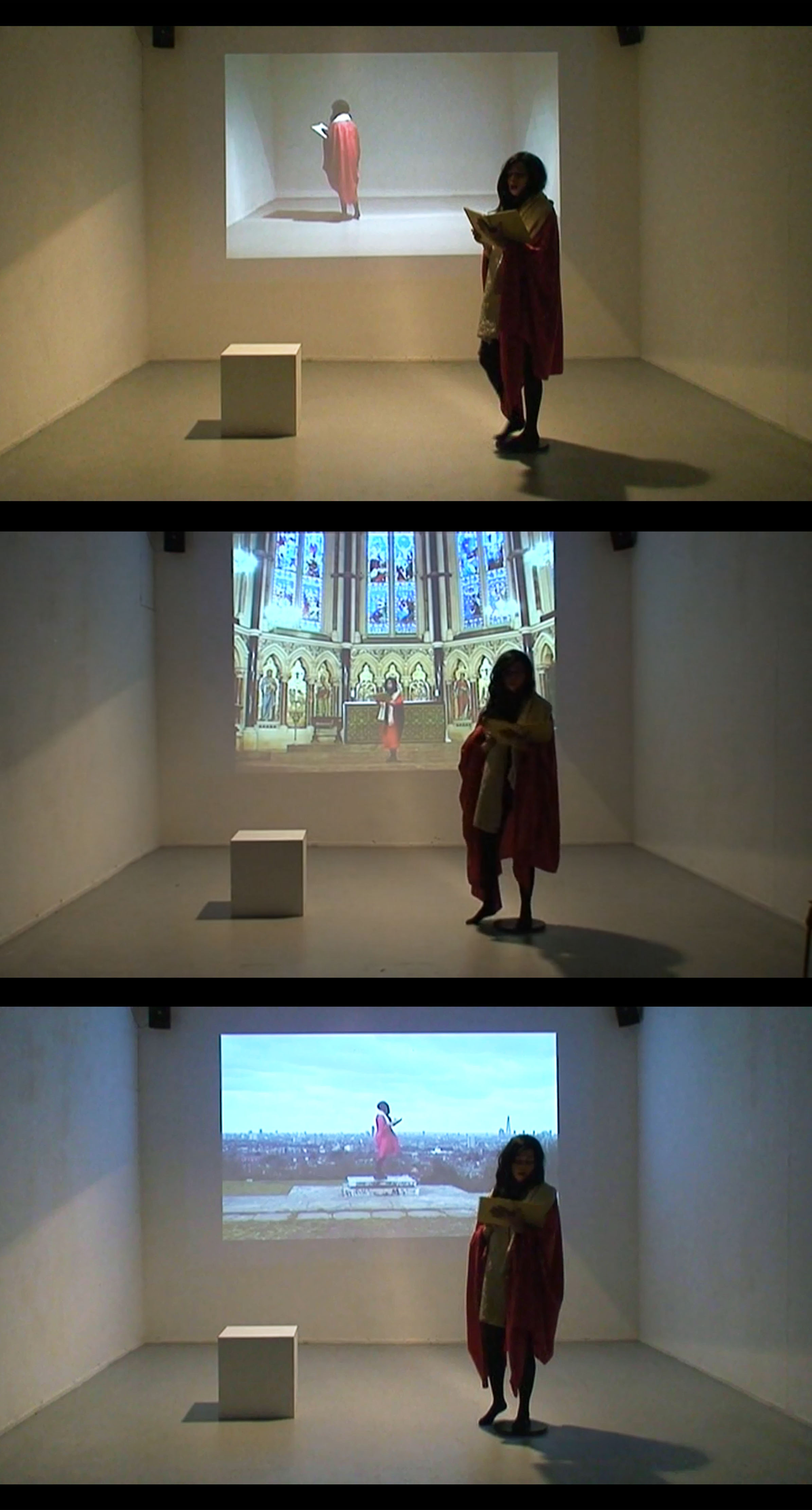Owed to (C)ode – video, improvised vocal performance, libretto – May 2015 (ongoing)
Owed to (C)ode is a self-referential video (and live performance) exploring and questioning the notion of an original and the tensions between image, text and music.
Owed to (C)ode originates from documentation of my performance High Art (iPhone Serenade) in the Apple Store, Rome, (August 2014) in which I serenade the iProp I constructed; – a piece of glass cut to the exact dimensions of an iPhone 5 covered in black and silver mirror film (dressed in an iPhone 5 case). I sang to the device in Italian. I transfigure a still image of the performance documentation from the file format .png (image) to .txt (text). I “translate” the images underlying code into phonetic Italian in a Microsoft Word document. I sing this code-libretto as a soundtrack to the video. I then drop this translation back into the .txt file and change the fusion of texts back into an image (.jpeg). The interference of the libretto causes the image to split apart, to dismember.
Owed to (C)ode – detail of libretto.
Owed to (C)ode: Oxford Edition – video, improvised vocal performance, libretto – November 2015 (ongoing)
Owed to (C)ode: Oxford Edition is a re-production of Owed to (C)ode created specifically for the opening of the Ruskin School of Art’s new Bullingdon Road Studios at Oxford University in October 2015. Oxford Edition collides recent and historic events of Oxford University and a recent residence in South Africa.
My attendance at Haroon Gunn-Salie’s show History After Apartheid (Goodman Gallery, JB) and active presence at his talk In Conversation with Adejoke Tugbiyele resulted in a profound contextualisation of two prominent events at Oxford University in 2015.
Gunn-Salie’s show featured his work Soft Vengeance; casts of the arms of imperialists Jan van Riebeeck, Bartholomew Dias, Cecil John Rhodes, Carl von Brandis and Paul Kruger. These arms, cast directly from their respective statues across Cape Town and Johannesburg, gigantic and blood-red, were profoundly moving and a strong reminder of the scale of their presence in history, and their global legacy.
During the Q&A I spoke of recent events at Oxford University. There was a debate at the Oxford Union in May 2015 entitled ‘This house believes Britain owes reparations to her former colonies’. On the day of this debate, students of the Oxford Union created the ‘Colonial Comeback Cocktail’ featuring an image of black hands in chains alongside the ingredients for, and price of the drink distributed on flyers and posters. I framed this information as a horror story, as opposed to a question, to the artists and audience at the talk. . It is clear that the idea of a post-Apartheid or post-colonial existence is far from a reality.
The other significant event at Oxford University in 2015 was Encaenia. The opera singer Jessye Norman was amongst the recipients of an honorary degree. I was informed by my father, a black classical musician who has found much solace in Norman’s existence, which I have inherited. Norman’s documented performance of Purcell’s When I am Laid in Earth is a favourite of mine. She commands, through Purcell, that we remember her.
I juxtapose her image in song with the two sets of arms and hands – the bloody imperialists’ and the enslaved blacks’. I sing the code of the constructed image as libretto in Zulu. I feed my phonetic translation back into the original image which glitches it (in a quite poetic partial obfuscation of the vicious title of the cocktail).
Art’s existence is for observation, creative criticality, collision of conflicting ideas and to use site, time and place in performance for maximum effect; how better to express my complex and sensitive issues regarding race and history specific to the institution than in the institution itself? Simultaneously public (a large audience) and private (only open to students, staff and alumni of Oxford University).
I am also confident in the knowledge that the artist can get away with almost any observation, critique, presence, through opera- it is non-threatening, it is revered as a fine craft, a high art – its sweetness, its aesthetic filter on the voice, its deliverance of its content fused with melody coerces the audience into a sense of importance. I use opera to subvert. My voice is my weapon. Opera is my code for critique.
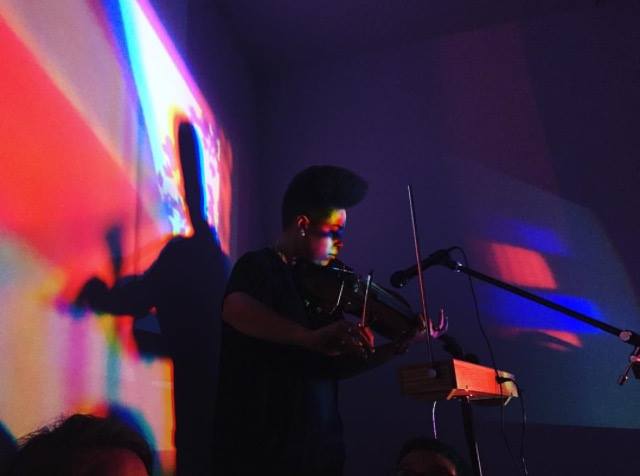
Music of the Spheres – live performance, vocals, theremin, viola, visuals – November 2015
In collaboration with Diana Policarpo and Camilla Padget-Coles. Peninsula Gallery Red Hook, Brooklyn, New York.
A re-imagining of Johanna Magdalena Beyer’s 1938 composition Music of the Spheres for strings and electronic instrument. Beyer was a social activist and composer, the first female composer to write for electronic instruments.
Ether-real Arias: Owed to Orpheus: I (Fire) II (Ocean) – video, improvised vocal performance, libretto – October 2015 (ongoing)
A live audio-visual enactment of a text I wrote on the myth of Orpheus. I perform the etymology of two contemporary Orphic songs; I (Fire) uses the opening bass line from Arcade Fire’s Awful Sound (Oh Eurydice) (2013), II (Ocean) uses the opening string motif of Frank Ocean’s Thinkin Bout You (2012). These live-sampled references are the point of departure for each “cover”. A video of my (accelerated) Google searches on Orpheus provides the visual backdrop. I improvise the layers of each track.
The two tracks are symbiotic – I (Fire) broadly represents the journey to and descent into the underworld. II (Ocean) broadly represents the ascent to the upperworld and/or beyond.
I am enacting a sonic and visual representation of my research. I use my voice, viola, (etherwave) theremin and loop pedals to construct the soundscape.
I want to perform the connection between image, music and text. I want to activate my research as performance outside the institution and outside of its boundaries, which language dictates. Categorisation, as useful and necessary as it is, excludes; when boundaries are blurred, freedom can occur, freedom of thought and experience in real time and space through live performance.
Owed to the Uncanny – improvised vocal/theremin performance, objects, video, lighting – May 2015
One summer’s day in 2008 I bought a can of coconut water from the local newsagents. The feel of the vessel, its weight, size and shape; the three groves at the top and bottom, the shape of the ringpull – these characteristics were new, but familiar.“Uncanny” I said. The standard 330ml can (Coke, 7up Pepsi etc.) had been ingrained into my physiology as far back as I can remember. This new can format has continued to amaze me in the most banal fashion.
The similarity between the timbres of (my) operatic voice and the theremin is a recurring theme in my artistic and musical practices. Owed to the Uncanny is a celebration of the hauntingly similar entities of timbre and object in time and space.
The recurring theme of the ode is being explored as I decide what to sing and to whom/what I aim my song at. An ode is owed, in debt to, an idea or concept. This ode is owed to parallel observations of can and instrumental timbre in an absurd self-referential vortex resulting in a time-based experience for performer and audience.
Sight Reading – composition, live improvised performance – May 2015
The idea of reading music is taken literally in Sight Reading. Members of Peckham Chamber Orchestra (PCO) sight read selected tweets from Kenneth Goldsmith’s Twitter account as music on site, at Goldsmiths, as a cited reference to Goldsmith’s philosophy on plagiarism and poetry. I, the founder, manager and conductor of PCO, lead the quintet by keeping a steady tempo.
This experiment reveals the relations between notations of text and music; language. The letters and symbols we see in the context of literature and music respectively transform “meaning” when read in this way. ABCDEFG are all playable pitches, the letter ‘h’ may become the playable pitch ‘b’ if the player speaks German. Hashtag ‘#’ becomes sharp ‘#’. The players navigate the text-music and respond to each others’ decisions – Sight Reading straddles the boundary between score-reading and improvisation.
The language surrounding Twitter’s command to ‘compose a tweet’ is taken literally in Sight Reading; the 130 character limit becomes phrasing, the text becomes sound, the repeated text of @Kenneth Goldsmith becomes a motif. The performance was retweeted by Kenneth Goldsmith himself. As part of the Finale of Acts IX-V (A week-long solo installation show I produced and performed daily in) I performed a solo of the tweet correspondence between Goldsmith and myself on viola.
Opera(tion) Skype March 2013
A live performance via Skype (London/Sweden). I sing Una donna a quindici anni from Mozart’s Cosi fan tutte and the preceding libretto.
I was essentially hired as an undercover opera singer by two Swedish artists (who wish to remain anonymous) to further communication between two other Swedish artists. I performed the aria with no other verbal communication.
Through this performance, I have been embroiled in their artistic practice in a way that is out of my control; the aftermath of the performance is still unfolding.
Speech! Speech! – speech notes, dictaphone, live improvised song – March 2014 – Vitrine Gallery London
Speech! Speech! is a speech about speech; the act of speech (speaking) and the social construction of giving a speech.
My speech addressed the tensions between text, spoken word and song, and the presence/absence of the performer through the recorded voice.
High Art (iPod/iPhone Serenade) – live vocal performance, broken iPods/iPhones 2011 – ongoing
Across dual sites I serenade broken iPods/iPhones. In the gallery I am given the illusion of great physical height (through sitting on top of a ladder or stood on a plinth disguised as a dress). I serenade two of my broken iDevices.
In the Apple Store I ask a genius why my iDevices break within days of the warranties. He explains. I begin to sing Che Faro Senza Euridice?from Gluck’s Orfeo and Euridice (1762) as a manifestation of consumer frustration and a questioning of the values of live music vs. recorded music.
In 2011 I performed in the Apple Store Covent Garden to a broken iPod. I re-enacted this scenario in Apple Stores in Paris (Opera 2013) and New York (Upper West Side 2013). In Rome 2014 I performed another Orphic aria – Gluck’s Chiamo il mio ben cosi? (Objet de mon amour) to an object I constructed – the iProp. A discussion with the genius followed about the global obsession with phones.
High Art (iPod Serenade) – live vocal performance, broken iPod, ladder, fabric. Peckham Space – 2012
Scarborough Fair(play) April 2013 – Surface Gallery – Nottingham
A live performance of the traditional English ballad Scarborough Fair. I duet with my pre-recorded self played on the TV in front of me. I do not break eye contact with my TV self. When I have completed a recital of the song, I press play and repeat the vocal duet.
This performance was conceived for Lisa Selby’s solo show With and Without at Surface Gallery, Nottingham, April 2013. I wanted to create a performance sympathetic to her work. I wanted to confront the audience with an image, atmosphere and soundscape of (almost child-like) domesticity and nostalgia. These ideas inform the choice of song; a departure from my usual operatic renditions.
Access All Arias Goldsmiths MFA Show – 2012
In a custom-built amphitheatre I serenade audience members one on one. I sing an operatic aria whilst filming the viewer with a video camera. The footage is both recorded and live streamed to a TV monitor next to me. I use the camera to highlight elements of the structure we are in, zooming in on the grain of the wood and tracing its form.
By serenading a camera, not breaking eye contact with it in the presence of another, I am confronting the way in which we lead our lives besotted and physically engrossed by the disseminating possibilities of technological devices.
I performed for a total of 17 hours during the 5 days of the exhibition. When I was not performing, I played back the footage I had generated during the performances on the monitor within the structure.
Diva’s Dress – 2012
I had a replica of the dress Wilhelminia Fernandez wears in Jean Jacques-Beneix’s 1981 film Diva constructed by artist and friend, Umi Baden-Powell, for my performance installation Access All Arias.
Pergolesi Susan Goldsmiths -2012
I sing the first movement of Pergolesi’s Stabat Matar repeatedly whilst rotating on a lazy Susan mechanism. I am accompanied by my pre-recorded and projected digital self. I sing the soprano part live and the alto part in the projected recordings.
There are three significant sites featured in the footage depicting the repetitions; a church, a seminar room and a natural beauty spot). I am attempting to communicate with my past self – to go through the memory of performing it in the past with each repetition of the song.
